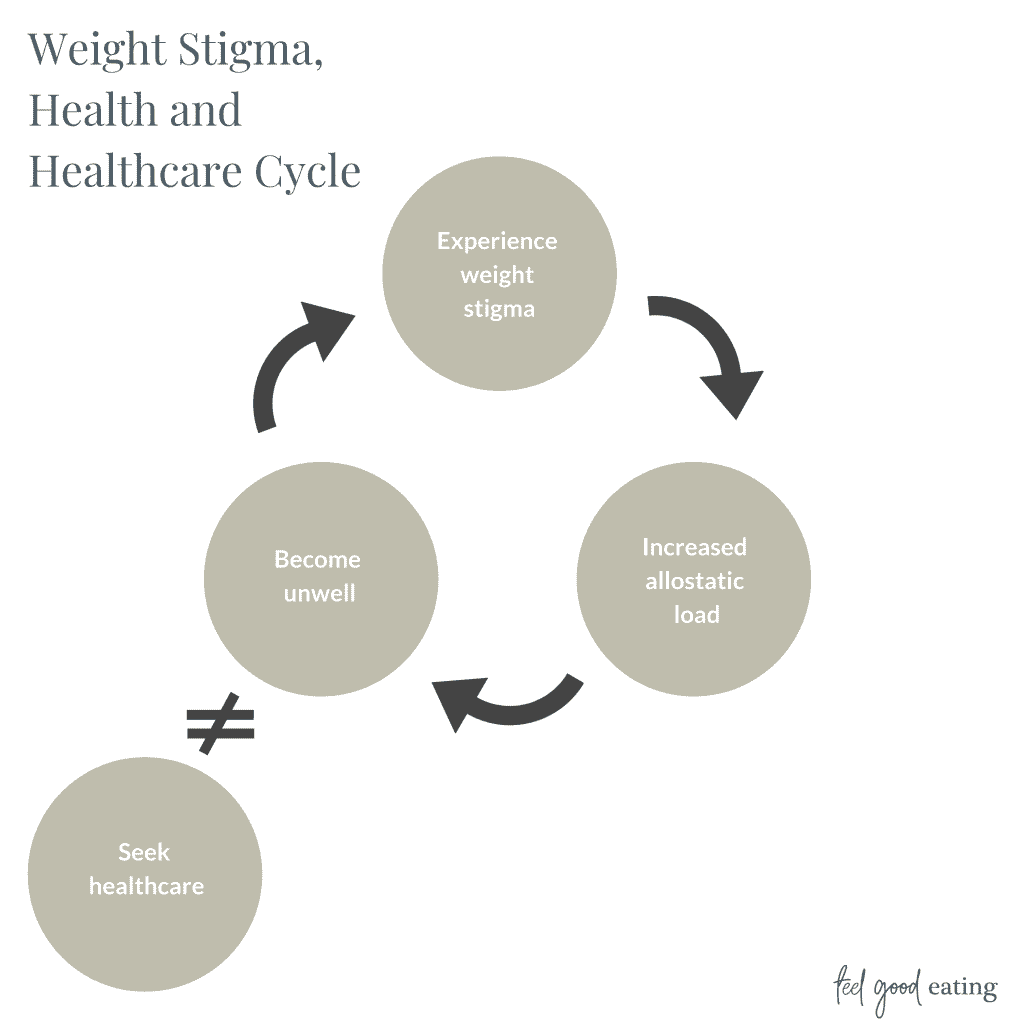Weight stigma is a term that is commonplace in the anti-diet, HAES and eating disorder spaces. But if you are unsure exactly what weight stigma is, this article offers a quick(ish!) explainer.
Weight loss is often pursued because of the immense pressure placed upon people to take up less space in the world.
This pressure to take up less space comes from:
Our physical environment: public transport seats, airline seats, toilet stalls, waiting room chairs, clearance between tables in cafés and restaurants etc getting smaller and smaller.
Our healthcare system: weight loss and in a lot of cases, bariatric surgery, being the default treatment prescribed, medical gowns that don’t cover the body, blood pressure cuffs that don’t go around arms, treatment being prescribed based solely on size, health insurance coverage based on size, people with eating disorders being told they can gain weight, but not too much OR being made to lose weight as part of their recovery.
Entertainment: fat people being cast as the ‘funny’ or ‘goofy’ friend rather than the lead, fat characters being the butt of jokes, scripts including fat jokes.
Fashion: physical stores and labels only catering to a narrow size range, using flimsy materials and stitching.
Online: trolling of larger bodies, smaller bodies are elevated and given ‘influencer’ status. People in smaller bodies delivering the same message as people in larger bodies being given more attention and credibility.
Politics: erasure of bigger bodies on the quest to ‘solve’ the ‘o****ty epidemic’, healthcare funding allocation, adoption laws etc.
Loved ones: embarrassment, awkwardness or distaste about fat bodies wrapped up in health ‘concerns’ or blatant comments and criticisms about bodies.
Societal stereotypes: fat people are ‘lazy’, ‘unintelligent’, ‘unhealthy’, ‘unlovable’ etc.
Note that these are just a few examples of where this pressure exists in our world.
These examples of pressure are actually, more fittingly, forms of discrimination, and collectively, are known as weight stigma. They occur because we live in a period of time where EVERYTHING in our world favours, prioritises and praises thinness over fatness.
And the amount of discrimination built into our culture and systems against large bodies, means that even people who aren’t in objectively bigger bodies internalise this pressure to take up less space. This often shows up as a fear of weight gain and with them taking steps to keep their weight the same.
It is an ugly, unjust business that has a negative impact on ALL bodies across the size spectrum but of higher importance is the incredible harm it causes people in larger bodies.
how is weight stigma harmful?
In a 2017 study, it was found that high levels of weight stigma were associated with more than twice the risk of high allostatic load.
Allostatic load is a term that describes the ‘wear and tear’ on the body that occurs with repeated or chronic exposure to stress – particularly on the cardiovascular, metabolic and nervous systems. Repeated exposure to weight stigma in the ways that have been described above, is felt and processed in the body as chronic stress.
In the same study, it was found that people with higher levels of weight stigma also had higher risks of cardiovascular disease, hypertension, type 2 diabetes and mortality. This was independent of weight.
A systematic review in 2018 found that weight stigma was associated with increased cortisol levels (our stress hormone), increased risk of depression, anxiety, eating disorders, body image dissatisfaction and low self-esteem.
Weight stigma makes people sick.
But, here’s the rub.
Experiencing weight stigma has also been linked to healthcare avoidance. So, weight stigma contributes to poorer physical and mental health, independent of a person’s weight AND weight stigma often prevents people from seeking the healthcare they need to take care of themselves for the adverse health outcomes they have sustained as a result of weight stigma.
It’s a lose-lose cycle to be caught in.
The alternative is to pursue weight loss. However, weight stigma driving the pressure to lose weight often leads to weight cycling which has been found to contribute to increased heart disease risk, increased risk of hypertension, chronic inflammation and higher mortality.
Whatever angle you come at it; weight stigma is extremely harmful.
Size diversity has always existed throughout history and will continue to do so. Instead of increasing the pressure on people to shrink their bodies, what we need is to put pressure on a radical change to our culture, politics and healthcare.
References
Bacon L, Aphramor L. Weight Science: Evaluating the Evidence for a Paradigm Shift. Nutr J. 2011;10(1):9.
Phelan SM, Burgess DJ, Yeazel MW, Hellerstedt WL, Griffin JM, van Ryn M. Impact of Weight Bias and Stigma on Quality of Care and Outcomes for Patients with Obesity. Obes Rev. 2015;16(4):319-326.
Tylka TL, Annunziato RA, Burgard D, et al. The weight- inclusive versus weight-normative approach to health: evaluating the evidence for prioritizing well-being over weight loss. J Obes. 2014;2014:983495.
Vadiveloo M, Mattei J. Perceived Weight Discrimination and 10-Year Risk of Allostatic Load Among US Adults. Ann Behav Med. 2017;51(1):94-104.
Wu Y-K, Berry DC. Impact of weight stigma on physiological and psychological health outcomes for overweight and obese adults: A systematic review. J Adv Nurs. 2018;74(5):1030-1042.



 Hi! My name is Nina.
I’m a Certified Intuitive Eating Counsellor taking the ‘diet’ out of Dietitian. I am here to help you reject diet culture, tune into your body’s own inner wisdom about how to truly nourish yourself and ultimately feel good eating™
Hi! My name is Nina.
I’m a Certified Intuitive Eating Counsellor taking the ‘diet’ out of Dietitian. I am here to help you reject diet culture, tune into your body’s own inner wisdom about how to truly nourish yourself and ultimately feel good eating™ 

Such an excellent and well explained post. I’m so glad this turned up in my inbox! Looking forward to looking at the referenced studies. We need more people understanding of this ??
Thanks Tasha – glad to hear it arrived at the right time for you.